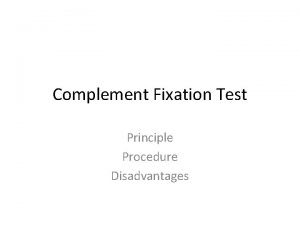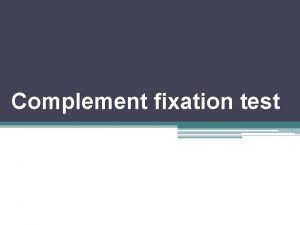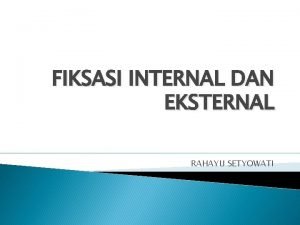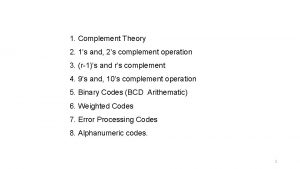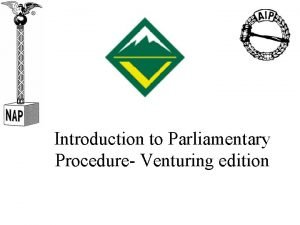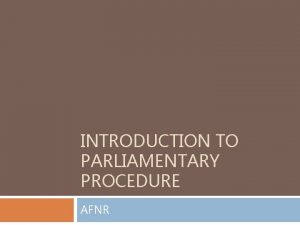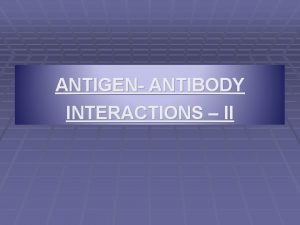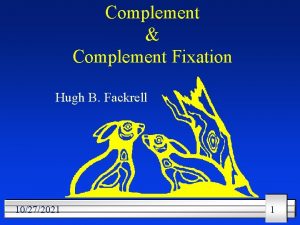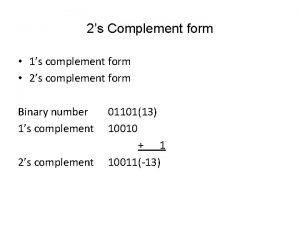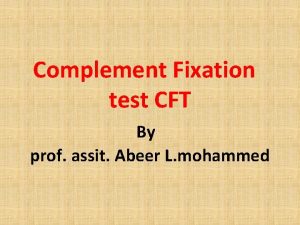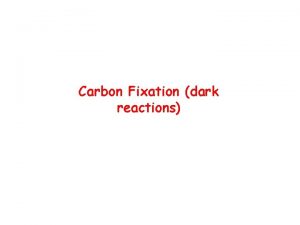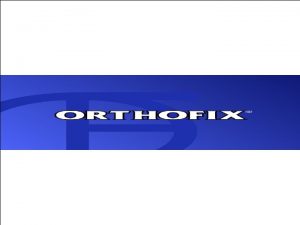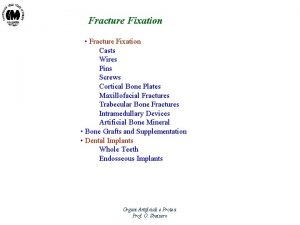Complement Fixation Test Principle Procedure Disadvantages Introduction Complement













- Slides: 13

Complement Fixation Test Principle Procedure Disadvantages

Introduction: • Complement is a protein (globulin) present in normal serum. • Whole complement system is made up of nine components: C 1 to C 9 • Complement proteins are heat labile and are destroyed by heating at 56°C for 20 – 30 min in a process called heat inactivation. • Complement binds to Ag-Ab complex • When the Ag is complexed with Ab on surface of cell , Complement causes lysis of cell.

Components of CFT Test System • Antigen: It may be any Ag, soluble or particulate. • Antibody: Human serum (May or may not contain Antibody towards specific Antigen). • Paired sera are used to detect recent infection( one at acute stage of disease, the other taken 2 weeks later(convalescent stage) • Complement: It is pooled serum obtained from 4 to 5 guinea pigs. It should be fresh or specially preserved as the complement activity is heat labile (stored at -30 °C in small fractions). The complement activity should be initially standardized before using in the test. Indicator System (Hemolytic system) • Erythrocytes: Sheep RBC ct as Ag • Hemolysin: Rabbit antibody to sheep red cells prepared by inoculating sheep erythrocytes into rabbit under standard immunization protocol.

Principle Complement fixation – Components of the test system : Patient serum, test known Ag. – Components of the indicator system : It contains sheep erythrocytes RBC and its corresponding antibody and is used as an indicator which shows the utilization or availability of the complement.

Principle • Complement binds to Ag-Ab complex and gets absorbed during the combination of antigens and antibody. • This property of antigen–antibody complex to fix the complement is used in complement fixation test for the identification of specific antibodies. • If the complement is fixed on test system(Ag + Ab), then there will be no lysis of sheep erythrocytes, thus denoting a positive test. • If the complement is available not bound to test system, it will be free to combine with indicator system resulting in hemolysis denoting a negative test.


CFT Ab present Test system+ C Ag Indicator system No Ab indicator system+ C Ag C NO lysis Lysis

Results and Interpretations: • • No hemolysis is considered as a positive test. Hemolysis of erythrocytes is indicative of a negative test. 1 2 3 4 A B • Microtiter plate showing Hemolysis (Well A 2, A 3 A 4, B 4) No Hemolysis (Well A 1, B 2, B 3 )

Determination of Ab titer of patient serum against Mycoplasma Ag • Procedure: • • • • 1. Add 25 ul of CFD to wells 2 through 10 in row A, and to wells 2, 3, 4 of row G, H. 2. Add 50 ul of CFD to wells 11, 12 of row A, and to well 1 in rows G, H. 3. Add 75 ul of CFD to well 12 in rows G, H (cell control wells). 4. Add 25 ul of 1: 8 diluted patient serum (I or II) to wells 1, 2 and 11, 12 of row A 5. Make doubling dilution from well 2 through 9, transferring 25 ul each time. 6. Discard 25 ul from well 9 7. Add 25 ul of mycoplasma Ag to wells 1 to 10 in row A. 8. Add 25 ul of negative Ag to well 12. 9. Add 25 ul of complement to all wells 1 -12 in row A. 10. Add 25 ul of complement to wells 1, 2 of rows G, H (complement control wells) 11. Make doubling dilution in rows G, H transferring 25 ul from 2 to 3 then from 3 to 4, discarding 25 ul fromwell 4. 12. Add 50 ul of CFD to wells 2, 3, and 4 of rows G, H (C' control wells). 12. Mix and incubate overnight at 4 c. 13. Add 25 ul of sensitized sheep red blood cells to all wells; incubate 1 hour at room temperature. Then read results.

Procedure outline 1 2 3 4 5 6 7 8 9 10 11 12 25 ul CFD 50 ul CFD Ser I 25 ul Ser II 25 ul 25 ul Myco Ag Comple -ve Ag Indicator System

Cell and Complement Control Wells Complement wells: 1 -4 cell wells : 12 1 2 3 4 5 6 7 8 9 10 11 12 50 ul ASO buffer 25 ul CFD 75 ul CFD 25 ul C 50 ul CFD Indicator system 25 ul Indicator system

CFT Reading results • Ab titer: Read 4 fold rise in Ab titer( 2 well diff) or more to be clinically significant. • Starting Ab dilution will be 1: 8 , then doubling dilution, so it will become 1: 16, 1: 32, 1: 64 , etc. • Controls well 10, 11, 12 result: lysis( well 10: no Ab, well 11: no Ag, well 12: –ve Ag) • Cell control wells( well. G 12, H 12: no lysis) • Complement control wells G and H: 1, 2, 3, 4 Wells 1, 2 lysis. Wells 3, 4 no lysis 12

Advantages and disadvantages • Advantages • large variety of test antigens can be used • Reading is easy ( lysis, no lysis) • More sensitive than other 2 serological tests • Disadvantages: • Demand on equipment and reagents is large • Some of components need to be fresh( RBC’s, Complement) • Less sensitive than 1 serological tests ( IFA, Elisa)
 Complement fixation test principle
Complement fixation test principle Complement fixation test advantages and disadvantages
Complement fixation test advantages and disadvantages Fiksasi internal
Fiksasi internal Complement fixation
Complement fixation Venn diagram terms
Venn diagram terms The 2's complement of 15 is
The 2's complement of 15 is Admission of an ambulant patient
Admission of an ambulant patient Introduction to parliamentary procedure
Introduction to parliamentary procedure Introduction to parliamentary procedure
Introduction to parliamentary procedure Which phrase best describes the process of sampling
Which phrase best describes the process of sampling Oral fixation examples
Oral fixation examples Freud fixation theory
Freud fixation theory Sigmund freud psychodynamic approach
Sigmund freud psychodynamic approach Single sling in suspension therapy
Single sling in suspension therapy
